Texas drought causes water shortages
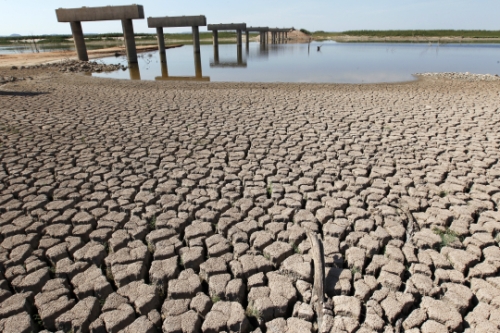
Latest projections indicates that state’s population will double to 46 million over the next half-century. It means that the days of cheap and abundant water are coming to an end, and where the additional supply will come from is not clear.
Sixty years after the devastating drought of the 1950s, the worst-case dry spell in Texas history, the state gripped once again by a record-setting drought. Lawmakers are balking at the price tag of a plan designed to meet demand for the next 50 years – a staggering $53 billion for more reservoirs, desalination plants and pipelines, among other projects. Texas hasn’t opened a major reservoir since 1987, though a small one near Nacogdoches was completed in 2005.
Blazing temperatures from June through August resulted in Texas and Oklahoma breaking a 117 year old record for the hottest average temperature recorded in any state, according to the Texas State Climatologist. The statewide average temperature was expected to be about 86.7 degrees, far surpassing the old record by almost 1.5 degrees. The average high temperature exceeded 100 degrees at all stations except those on the coast, and more than 95 percent of Texas remained in either severe or exceptional drought status. The situation prompted new calls for State Water Plan funding, which has been almost non-existent since the plan was passed in 1997.
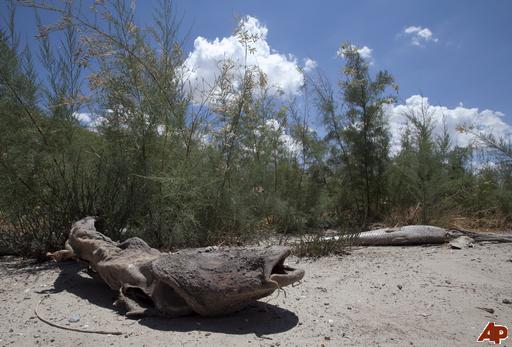
Most of the groundwater used in Texas is used for agriculture. Although the percentages vary slightly from year to year, about 80 percent of all groundwater used in Texas is for irrigating crops. In many parts of the state, more groundwater is being used than is being replenished through natural means. If this practice continues, Texas water costs will rise, land could subside, water quality could decline and people in some areas could run out of water.
Texas – River Basins, Major Bays and Streams map (Texas Parks and Wildlife)
Currently, 18 cities are high priority -they’ll either run out of water within 6 months unless the rains come, or they don’t know how much water they have. Texas’ water supply for the future is uncertain, and the health of Galveston Bay, home of the state’s most commercially productive estuary, is in jeopardy. In the meantime, the state is blithely planning multiple power projects to meet projected population growth – 9 coal plants in planning stages will be added to the 19 -20 coal-fired power plants already in the state. A structural water shortage is a permanent water shortage that can only be solved by a drastic change — less agriculture, less people, more water from somewhere else (possibly from Oklahoma).
Water. Coal. Fracking. Texas. Sanity. One of These Words Does Not Belong (ThinkProgress)

Current drought is already the worst one-year dry spell in Texas since records started being kept in the 19th century and it will last another year, and possibly for a decade, the state’s climatologist says. Some 96 percent of the state’s major reservoirs were below 60 percent capacity as of the end of October. Unless Texas grows its water resources, experts say 83 percent of Texans will not have an adequate supply of water in times of drought.
“There’s no way we’re going to have enough water 50 years from now to take care of the population growth. We’re now in a situation where we may not be able to take care of the water needs in this state for the next 15 years.” former state Rep. Ron Lewis, who chaired the House Energy Resources Committee
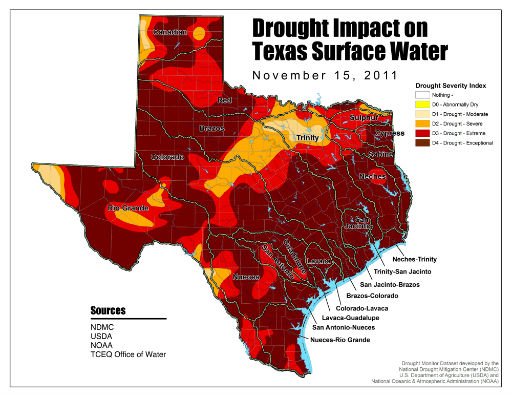
Texas has all or part of 20 major land resource areas covering 168 million acres. Average annual rainfall varies from 5 inches on the west to 55 inches on the east. Seasonal patterns exist but frequent droughts and major storms of high intensity are common. The state has pressing needs for the development of additional water supplies and wastewater treatment. (NRCS)
TAP computer modeling based on state water models suggest that the instream flows to the bays and estuaries are being negatively impacted due to over-allocation for upper basin needs, which becomes manifest during a natural drought. If the bays are unable to survive, it is only a matter of time before the entire river basin is put in jeopardy because mismanagement in any part of the basin hurts everybody.

Map of monthly average streamflow in the State of Texas
Dried lakes
The North Texas Municipal Water District, which serves hundreds of thousands of North Texans, says it’s preparing for the possibility that it could run out of water. The district fears it may not be able to pump from Lake Lavon in two years; that’s the worst-case scenario. The lake’s normal level is 492 feet. Right now, it’s at 479 and dropping. Some of Lake Lavon’s coves are already bone dry. The lake is more than half-empty.
Part of the current problem is an infestation of zebra mussels at Lake Texoma. It shut down the pipeline that carries water to Lavon, which supplies the district with more than a quarter of its supply. District leaders want to build a 42-mile extension of that pipeline that would bypass Lavon. (KVUE)
And municipal drinking water is becoming a big concern. Some lakes have dried up completely. O.C. Fisher Lake in San Angelo, Texas, once covered 5,400 acres. Now there’s nothing much left other than deeply cracked earth and the dessicated bodies of dead fish. Other lakes suffering severe drought conditions include Baylor Creek Reservoir, Greenbelt Reservoir, McClellan Reservoir, Palo Duro Reservoir, Lake E.V. Spence, and Lake Meredith; Fairfield Lake had a huge fish kill due to extreme heat conditions resulting in deoxygenated waters.
Lake Conroe, dropping the water levels two feet per month. Lake Houston, the normal water reservoir for the city, is at critically low levels. The Texas town of Robert Lee is attempting to hoard the water from Lake E.V. Spence, pumping the remaining water around the clock to move what little is left into a reservoir for the town’s exclusive use, protecting it from other communities, and which they hope will last until next spring. The actual water is terrible: Lake Spence’s tiny remnant of water is thick with saline and sunken dead matter, almost too contaminated to be treated.
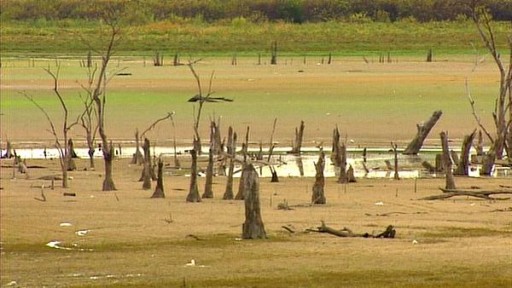
Trinity River, which runs for 715 miles from the Oklahoma line to Galveston Bay, don’t have enough water to meet competing demands . The rain-fed stream supply water for Texas’ two largest metropolitan areas, Dallas-Fort Worth and Houston, and the demands will only grow with an increasingly urban population. The Trinity’s northern basin receives 27 inches of rain each year, while the southern basin gets 51 inches a year, according to the Trinity River Authority. But the Trinity, like many other Texas rivers, is tapped, with virtually every drop appropriated by farmers, industries and boundless cities. Trinity runs along Dallas downtown where many see the river as nothing more than a muddy ditch, too polluted to swim or fish. Every major tributary went dry north of Dallas and Fort Worth this year, while reservoir levels dropped. Lavon Lake is at about half its capacity.
The Trinity basin alone has 32 reservoirs, with a storage capacity of more than 7 million acre-feet of water. One-acre foot, equal to about 326,000 gallons, is enough to serve two typical Texas families for a year according to HoustonChronicle. The state plan calls for as many as four new reservoirs in East Texas and a pipeline to import Oklahoma water. But federal court recently blocked plans to import Oklahoma water after the state argued that its law prevents nonresidents from purchasing water rights. The Choctaw and Chickasaw nations also have filed suit, saying the water belongs to them, not Oklahoma, because of a treaty with the United States. And East Texas property owners are fighting plans to dam the Sulphur River for the proposed Marvin Nichols reservoir. If approved, the project, the largest proposed lake in the Region C plan, would flood more than 70,000 acres of mostly private property.
Texas Aquifers
According to the Texas Water Development Board, nine aquifers supply about 97 percent of the groundwater used in Texas. The major aquifers have different annual pumping rates, recharge rates and projected safe annual availability rates. The other three percent is drawn from 20 minor aquifers.
| 1990 Pump Rates |
1995 Pump Rates |
Annual Recharge | Projected Safe Annual Yields | |
| Ogallala | 5.55 | 6.22 | 0.30 | 3.81 |
| Edwards (Balcones) | 0.53 | 0.47 | 0.44 | 0.44 |
| Edwards-Trinity | 0.19 | 0.25 | 0.78 | 0.78 |
| Carrizo-Wilcox | 0.45 | 0.49 | 0.64 | 0.85 |
| Trinity | 0.19 | 0.19 | 0.10 | 0.11 |
| Gulf Coast | 1.23 | 1.15 | 1.23 | 1.23 |
| Others | 0.32 | 0.39 | 0.43 | 0.97 |
| TOTAL | 8.56 | 9.16 | 3.92 | 8.19 |
SOURCE: Mary Sager and Cyrus Reed, Texas Environmental Almanac, 2nd ed. 11 (Texas Center for Policy Studies, 2000.)
In 1984, according to the Texas Water Commission, 57 percent of Texas’ water requirement was supplied by aquifers. About 15 percent of Americans have their own sources of drinking water, such as wells, cisterns and springs. Although most U.S. groundwater is safe for human use, groundwater contamination has been found in all 50 states.
Ogallala Aquifer
Ground water available in aquifers such as the Oglala Aquifer is a renewable resource. However, we are depleting the supply faster than the aquifer is replenished. Many people fear that, at current usage, the aquifer could be gone in as little as 25 years.
The Ogallala Aquifer, also known as the High Plains Aquifer, is a vast yet shallow underground water table aquifer located beneath the Great Plains in the United States. One of the world’s largest aquifers, it covers an area of approximately 174,000 mi² (450,000 km²) in portions of the eight states of South Dakota, Nebraska, Wyoming, Colorado, Kansas, Oklahoma, New Mexico, and Texas.
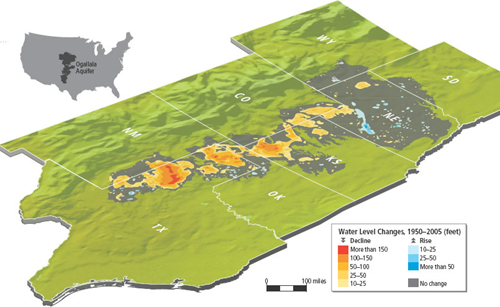
Many farmers in the Texas High Plains, which rely particularly on the underground source, are now turning away from irrigated agriculture as they become aware of the hazards of overpumping. This is the breadbasket of America—the region that supplies at least one fifth of the total annual U.S. agricultural harvest. If the aquifer goes dry, more than $20 billion worth of food and fiber will vanish from the world’s markets. And scientists say it will take natural processes 6,000 years to refill the reservoir.
New demands
Dallas residents use 213 gallons per person per day in their homes, compared with 134 for Houstonians. San Antonio, which relies on the Edwards Aquifer, an underground reservoir, uses 149 gallons per person per day, according to Texas Water Development Board‘s most recent data.
In 2008, TransCanada Corporation proposed the construction of the 1,661-mile (2,673 km) Keystone XL pipeline to carry oil from the Athabasca oil sands of Alberta to refineries near Houston. The proposed route of the pipeline crossed the eastern part of the Nebraska Sandhills; opponents of the project argued that this route posed an unacceptable risk to the Ogallala Aquifer owing to the possibility of contamination from oil spills. In August 2011, an environmental-impact report by the U.S. State Department found the Sandhills route would be the most economically feasible, and would be unlikely to have significant environmental impacts.
T Boon Pickens has moved to take over a certain part of the Ogallala water aquifer in northern Texas. He has been allowed to do this because he bought the land above it. Allegedly he was involved in a huge wind farm operation that went bust…..at the tax payer expense. Pickens said low natural gas prices have made utility companies view wind power as too expensive.
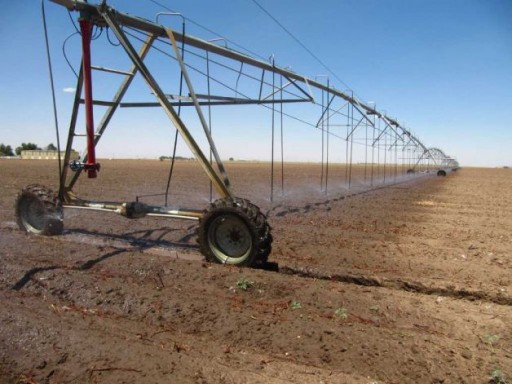
Growing populations throughout the Great Plains region are also demanding more municipal water from the only available source: the aquifer. T. Boone Pickens, the billionaire oilman and recent alternative energy advocate, is among the entrepreneurs who have entered the domestic water market. A Texas law granting landowners unrestricted rights to the water beneath their property makes it possible for Pickens to sell groundwater from his 24,000-acre Mesa Vista Ranch in the Texas panhandle to metropolises as far away as Dallas and El Paso. The 654-mile pipeline he plans to build to El Paso would cost $2.1 billion. But with water sales priced at more than $1,000 an acre-foot, profit is waiting to be had. (Nature)
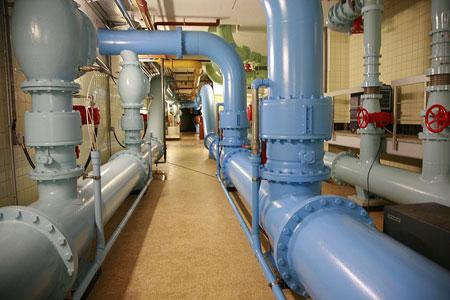
Smart water use guidance
- Take Care of Texas, supported by the Texas Commission on Environmental Quality, offers everyday tips for water and energy conservation.
- Water IQ: Know Your Water, supported by the Texas Water Development Board, is a statewide program educating Texans about water conservation.
- EPA WaterSense provides information on water efficient products and water conservation practices.
- To calculate your individual water footprint, visit H2O Conserve.
- A Watering Guide for Texas Landscape, provides practical advice on how to select turfgrasses, establish healthy landscapes, and water lawns and plants wisely.
The Environmental Defense Fund has concluded that Texas would save an additional 1 million acre-feet a year if every city reduced daily consumption to 140 gallons per person by 2060. Modeling water management in the 23 river basins of the state reflects about 8,000 water right permits and 3,400 reservoirs. The North Texas district has adopted Stage 3 restrictions in response to the ongoing drought – a move that will limit landscape watering to once every two weeks starting Nov. 1. The North Texas water suppliers have agreed to leave at least 30 percent of their treated wastewater in the river for Houston’s use. About 40 percent of what’s reused will return to the river and that should be enough to maintain Houston’s supply in Lake Livingston, water managers said.
After all that heated discourse, let’s cool off with what passes for humor these days in Texas from AddictingInfo.
How dry is it in Texas?
- The Baptists are now sprinkling. The Methodists have adopted the use of Wet Wipes. The Presbyterians are handing out rain checks. The Catholics are praying that the wine be turned back into water.
- The birds are building their nests out of barbed wire.
- The trees are whistlin’ for the dogs.
- The fish are knocking on the door, askin’ for a drink of water.
- You’re only permitted to eat watermelon between 8pm and 8am.
- The government has announced a water pistol buy back scheme.
- Crooks are siphoning off radiators instead of gas tanks.
- They’re encouraging people to pee in the pool.
- We’re fishin’ on lawn chairs with slingshots.
- We’re picking ticks off the fish before we scale ‘em.
- The mesquites packed their bags and headed for Minnesota.
- Your neighbors applaud your naked rain dance.
“There is enough water for human need, but not for human greed.” – Mahatma Gandhi

Water recycling (treating sewage for reuse) and desalinization are the answer. That and people in metropolitan areas need to get over the need for having grass lawns.
.This story deserves an award, its just fantastic. So many people need to know this
is happening . It would wake up a lot of people.